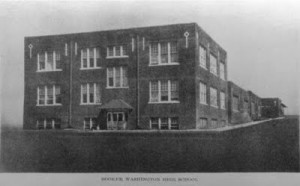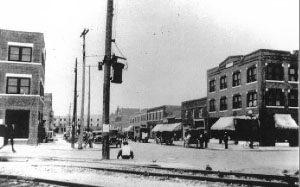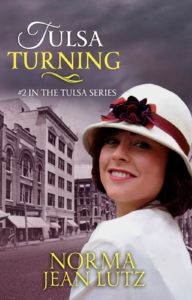Signs of the Times
In my last post regarding the Tulsa Race Riot (The Undercurrent that Sparked the 1921 Tulsa Race Riot), I mentioned that the signs of the times were like neon lights flashing across the sky. It was true for the nation, but it was even more true for Tulsa in that specific era.
As I have previously stated, segregation had forced the area known as Greenwood, to invest in their own community. They had become a self-sufficient and self-determined lot.
Greenwood Prospered
Greenwood was replete with prosperous businesses. This included realtors, doctors, dentists, teachers, attorneys, beauticians and barbers. Greenwood boasted rooming houses, restaurants, night clubs, hotels, bus services, airline charter service, hospital, movie theaters, schools and churches.
Booker T. Washington high school, built in 1913, had grown into a three-story, sixteen-room brick building. On May 31, 1921, the seniors were in a flurry of activities getting ready for their prom. Sadly, that prom never came to pass.

Booker T. Washington High School in Greenwood District
Vigilante Actions
The social climate in Tulsa in the years prior to the riot was one of increased vigilante actions and lawlessness. Not only was the Klan active (2,000 strong in Tulsa alone), but also the Knights of Liberty formed their own mobs and hate groups.
The Knights of Liberty took offense with the IWW (International Workers of the World) who purported racial equality. In 1917, a group of IWW men were whipped and tarred and feathered by members of the Knights of Liberty with no interference whatsoever from law officers.
Public Lynching
 Just nine months before the Race Riot a white boy — an accused murderer — was publicly lynched, which gives an even clearer idea of the tenor of the town at the time. (Take the word public literally. Hundreds of Tulsans turned out for the event as though it were a community picnic.)
Just nine months before the Race Riot a white boy — an accused murderer — was publicly lynched, which gives an even clearer idea of the tenor of the town at the time. (Take the word public literally. Hundreds of Tulsans turned out for the event as though it were a community picnic.)
Out of the three Tulsa newspapers, only one, the Tulsa Star (the black’s community newspaper), condemned the lynching. The silence of the others spoke volumes about Tulsa at the time. It was a population ready to accept quick justice – justice meted out by mob actions. One author writing about the times called it “string-him-up” mentality.
The Tulsa Tribune once sported this headline: “Tulsa appears now to be in danger of losing its prestige as the whitest town in Oklahoma.” Such sentiments couldn’t help but feed the already growing distrust of the burgeoning black community to the north of Tulsa.
Primed for the Explosion
On the one hand the community of Greenwood (Black Wall Street of America) fairly brimmed over with success and affluence. On the other hand, the resentment, suspicion, anger, bitterness, jealousy and envy continued to seethe just beneath the surface of the white community.
All was primed for the explosion that took place on May 31, and June 1, 1921.
![]()
Book #1 (Tulsa Tempest)
(Click the cover for more information.)
You can read Chapter 1 of Tulsa Tempest right HERE!
Free Download!
![]()
Book #2 (Tulsa Turning),
(Click the cover for more information.)
![]()
I’ve launched a YouTube video series that I call (for obvious reasons!) The Writing Life. These episodes reveal the ins and outs, and the ups and downs of a published author.
Be sure to subscribe so you won’t miss a single episode.
![]()

Tired of the struggle writing your book? Need a helping hand? Norma Jean’s Coaching Services may be the answer you’re looking for. Fill out the questionnaire on the page and let’s see if we’re a right fit. A FREE consultation gets the ball rolling. (Or the pen writing!) Click HERE!
![]()




